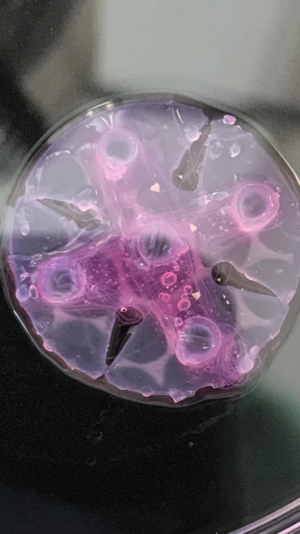Difference between revisions of "Bioactuator"
m (Tag: Visual edit) |
|||
| Line 20: | Line 20: | ||
- We have managed to fill the moulds with the collagen type 1 and cell mixture. Our next goal is to electrical stimulate the skeleton muscle cells in 2D culture. | - We have managed to fill the moulds with the collagen type 1 and cell mixture. Our next goal is to electrical stimulate the skeleton muscle cells in 2D culture. | ||
| − | - The electrical stimulation was successful. We have been working on on a couple of designs but we have now come to the conclusion that we will mainly work on the medusoid design. We will also start working with Kayoko Shoji's muscle fibers. | + | - The electrical stimulation was successful. We have been working on on a couple of designs but we have now come to the conclusion that we will mainly work on the medusoid design. We will also start working with Kayoko Shoji's muscle fibers. |
| − | |||
| − | + | [[File:Medusoid.png|thumb|Caption]] | |
-We have now made two medusoid designs, one with groves where we fill the muscle cell mixture and one with pillars which we twirl the muscle fibers around. Our next goal is to do electrical stimulation | -We have now made two medusoid designs, one with groves where we fill the muscle cell mixture and one with pillars which we twirl the muscle fibers around. Our next goal is to do electrical stimulation | ||
Revision as of 21:28, 16 August 2021
Introduction
Our goal is to make a functional biohybrid design that can preform locomotion. To manage this, the goal is to use a complex skeleton with one or multiple simple one-way flexing skeleton muscle tissue.
The cells used are the C2C12 myoblast cancer cell line from rats. The C2C12 cell line are progenitor cells (myoblasts), these cells will grow as long as there are vital substances, space and a health environment in the growth flask. But once there are no longer space they will differentiate into skeletal muscle cells, the cells can also be induced to differentiate.
The molds are made of polycarbonate??? and the skeleton used are made of silicon. Both the mold and the skeleton are 3D modelled in Fusion 360.
Maintenance of cells and engineering of the mould as well as skeleton is therefore the main parts of this project.
To engineer the tissue we use a type 1 collagen and cell gel in the mold, and growing them here for 2 weeks while they differentiate into muscle tissue.
Team
We are currently four undergraduate students, With three of us studying bioscience and one studying physics. Our supervisors are two postdocs at domus medica.
Progress
- We have managed to fill the moulds with the collagen type 1 and cell mixture. Our next goal is to electrical stimulate the skeleton muscle cells in 2D culture.
- The electrical stimulation was successful. We have been working on on a couple of designs but we have now come to the conclusion that we will mainly work on the medusoid design. We will also start working with Kayoko Shoji's muscle fibers.
-We have now made two medusoid designs, one with groves where we fill the muscle cell mixture and one with pillars which we twirl the muscle fibers around. Our next goal is to do electrical stimulation
Literature
